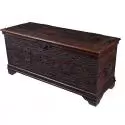Flowers & Monsters at the American Swedish Museum
 Article originally published by Eve. M. Kahn in the New York Times on March 31st, 2016. Posted here with introduction by ArtsAndCraftsCollector.com.
Article originally published by Eve. M. Kahn in the New York Times on March 31st, 2016. Posted here with introduction by ArtsAndCraftsCollector.com.
This week here at ArtsAndCraftsCollector.com, we’re excited to share with you an exhibition nearing its close. It is focused on the life and craft of a lesser known figure in the Arts and Crafts world, that of Karl von Rydingsvard. In researching this exhibition, the news of which was sent to us by one of our readers, we happened upon this article from the New York Times. It so wonderfully painted the picture of Rydingsvard that we thought we’d re-post it here in its entirety. Enjoy!
A forgotten collection of oak furniture by the Swedish-born carver Karl von Rydingsvard goes on view Sunday at the American Swedish Historical Museum in Philadelphia, returning this craftsman to the public eye a century after he briefly rose to fame.
Carrie Hogan, the museum’s senior curator, borrowed the antiques from descendants of a friend of the von Rydingsvard family. She has tracked down his other works from the early 1900s, including roomfuls of furniture carved for American industrialists. He rarely signed his chairs, chests, tables and panels, which he decorated with vines, fruit, medieval knights, Gothic pointed arches, Celtic knots and Norse monsters.
Ms. Hogan also uncovered biographical details that von Rydingsvard apparently tried to hide when he was alive. Although his parents technically belonged to the nobility, they inherited no land or fortune. Born in 1863, he grew up in a hamlet on the west coast of Sweden,where his family farmed, tended the grounds of a cemetery and ran a country store. As a teenager, von Rydingsvard (pronounced REE-dings-vehrd) made his way to Stockholm and then New York and Boston, working at furniture factories. By the 1890s he had brought most of his relatives to the United States and married Anna Davis, a linguist and historian from Boston who was a descendant of Magna Carta signers and 17th-century New England settlers.
He apparently exaggerated the loftiness of his inherited titles. His wife erroneously called herself Baroness von Rydingsvard. After her mistake was exposed in the press, she sued for divorce, but von Rydingsvard weathered the scandal. “He must have been incredibly charismatic,” Ms. Hogan said.
He set up schools for female carvers in Manhattan and Brunswick, Me., and taught at institutions including Columbia University, the Rhode Island School of Design and the school at the Museum of Fine Arts, Boston. By the 1930s, he had largely retired to Maine with his second wife, Ida, also a woodcarver.
He died in 1941 as a result of injuries from a fire. The fate of his business records is unknown, but his wares remain in some of the Tudor and Elizabethan buildings that he helped furnish, including the Hermitage Museum & Gardens in Norfolk, Va. The antiques on view at the Swedish museum in Philadelphia are ornamented here and there with his family’s coat of arms.
 The show was originally a collaboration with Robert Edwards, an expert on Arts and Crafts design in Swarthmore, Pa., but he died in 2014, and carvings from his estate have been dispersed; his chests and stools by von Rydingsvard have sold for up to a few thousand dollars each. (Mr. Edwards’s papers are at the Winterthur Museum, Garden and Library in Wilmington, Del.)
The show was originally a collaboration with Robert Edwards, an expert on Arts and Crafts design in Swarthmore, Pa., but he died in 2014, and carvings from his estate have been dispersed; his chests and stools by von Rydingsvard have sold for up to a few thousand dollars each. (Mr. Edwards’s papers are at the Winterthur Museum, Garden and Library in Wilmington, Del.)
Ms. Hogan said she hoped that more von Rydingsvard artifacts would surface. “We want to keep this conversation going,” she said.
We encourage you, our readers here at ArtsAndCraftsCollector.com, to be a part of that conversation by visiting the American Swedish Historical Museum before this exhibition closes on December 31st!
Top photo courtesy of the American Swedish Museum.
Bottom photo courtesy of LiveAuctioneers.com.
